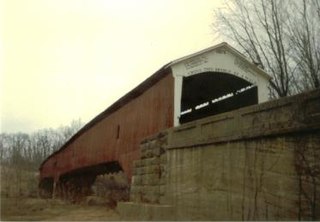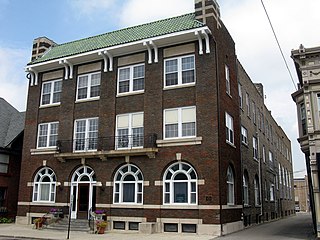
The Fort Wayne Old City Hall Building in downtown Fort Wayne, Indiana operates as a museum known as The History Center, and has served as headquarters for the Allen County–Fort Wayne Historical Society since 1980. The Richardsonian Romanesque style sandstone building was designed by the architectural firm Wing & Mahurin and built in 1893. It served as a functioning city hall for the city until 1971 when local officials moved to the City-County Building.

Johnny Appleseed Park, including what was formerly known as Archer Park, is a public park in Fort Wayne, Indiana. It is named after the popular-culture nickname of John Chapman, better known as "Johnny Appleseed", a famous American pioneer, who was buried on the site. Chapman's gravesite is accessible to public view through steel gates. The weathered tombstone says, "Johnny Appleseed He lived for others. 1774–1845." It also has a carved apple in bas relief.

The West Union Covered Bridge formerly carried Tow Path Road over Sugar Creek north-northeast of Montezuma, Indiana. The two-span Burr Arch Truss covered bridge structure was built by Joseph J. Daniels in 1876. It is notable for being the longest standing covered bridge in Parke County, and one of the nation's best-preserved examples of the Burr truss.

This is a list of the National Register of Historic Places listings in Tippecanoe County, Indiana.

Trinity Episcopal Church is a historic Episcopal congregation and church, designed by Toledo, Ohio architect Charles Crosby Miller and constructed ca. 1865 in Fort Wayne, Indiana. The congregation was organized in 1839 as Christ Church and the name changed in 1844 to Trinity Church. The first church was built on the northwest corner of Berry and Harrison Streets in 1850. It is an example of Gothic Revival architecture.

The Pennsylvania Railroad Station in Fort Wayne, Indiana, also known as Baker Street Station, is a former passenger rail station in downtown Fort Wayne, Indiana. The American Craftsman-style station opened to the public March 23, 1914, at a cost of $550,000.

Thomas W. Swinney House, also known as The Swinney Homestead, is a historic home located at Fort Wayne, Indiana. It was built in 1844-1845 as a 1+1⁄2-story brick and limestone structure. It was enlarged with a 2+1⁄2-story, square, Late Victorian style brick wing about 1885. It features an Eastlake movement front porch. It was built by Thomas J. Swinney, a pioneer settler of Allen County and prominent Fort Wayne businessman. The house and land for Swinney Park were passed to the city of Fort Wayne in 1922.

Wells Street Bridge is a historic Whipple truss bridge spanning the St. Marys River at Fort Wayne, Indiana. It was built by the Wrought Iron Bridge Company of Akron, Ohio and erected by Alvin John Stewart in 1884. It has a 180 foot long span and is 23 feet wide. It was closed to vehicular traffic in 1982 and used as a pedestrian walkway.
Hursh Road Bridge was a historic Whipple truss bridge spanning Cedar Creek near Cedarville, Allen County, Indiana. It was built in 1879 by the Western Bridge Works of Fort Wayne, Indiana. It was a 120 foot long, 16 feet wide ornate iron bridge.

Pugh Ford Bridge, also known as Bartholomew County Bridge No. 73, is a historic Pratt through truss bridge spanning the Flatrock River at Flat Rock Township and German Township, Bartholomew County, Indiana. It was built by the Elkhart Bridge and Iron Co. and built in 1911. It consists of two spans, with each measuring 128 feet long. It rests on concrete abutments and a concrete pier.

Dr. Havilah Beardsley House is a historic home located at Elkhart, Elkhart County, Indiana. It was built in 1848, and is a two-story, rectangular, Italianate style brick dwelling. It has a medium pitched gable roof, full width front porch with Ionic order fluted columns, rounded openings, and decorative brackets. It has later flanking one-story, flat roofed wings. It was built by Havilah Beardsley, founder of the city of Elkhart. The house is operated as a historic house museum as part of the Ruthmere Mansion complex.

Green Block, also known as the Smith Frye Building, is a historic commercial building located in Elkhart, Elkhart County, Indiana. It was built in 1895, and is a two-story, eclectic Italianate style brick commercial building. It features projecting pressed metal bays above each storefront and at the corners and arched second story openings with balconies.

Young Women's Christian Association, also known as the Elkhart Y.W.C.A. and Lexington House, is a historic YWCA located at Elkhart, Elkhart County, Indiana. It was built in 1919, and is a three-story, brick building on a raised basement and Bungalow / American Craftsman style design elements. It measures approximately 40 feet wide and 150 feet deep. It has a flat roof and arched openings on the first floor.

Elkhart County Courthouse is a historic courthouse located at Goshen, Elkhart County, Indiana. It was originally built in 1868–1870, and renovated between 1905 and 1908 in the Renaissance Revival style. It is a three-story, brick building with a clay tile dome tower. It features a portico with four freestanding Doric order columns, with stylized triglyphs, set on a rusticated podium.

Bristol-Washington Township School, also known as Bristol High School, is a historic school building located at Bristol, Elkhart County, Indiana. The original section was built in 1903–1904, with additions made in 1923, 1925, and 1949. The original building is a two-story, Colonial Revival style brick and limestone building on a raised basement. The original building measures 61 feet by 61 feet. The building houses the Elkhart County Historical Museum.

Beardsley Avenue Historic District is a national historic district located at Elkhart, Elkhart County, Indiana. The district encompasses 41 contributing buildings, 3 contributing sites, 2 contributing structures, and 2 contributing objects in a predominantly residential section of Elkhart. It was developed after 1848, and includes residences in a number of architectural styles including Prairie School and Beaux Arts. Located in the district are the separately listed Dr. Havilah Beardsley House and Ruthmere Mansion. Other notable contributing resources are Island Park, Beardsley Park, the Main Street Memorial Bridge, St. Paul's Methodist Church, and the Best House.

Elkhart Downtown Commercial Historic District is a national historic district located at Elkhart, Elkhart County, Indiana. The district encompasses 59 contributing buildings in the central business district of Elkhart. It was developed between about 1868 and 1930, and includes notable examples of Italianate, Queen Anne, and Classical Revival style architecture. Located in the district are the separately listed Green Block, Lerner Theatre, and Young Women's Christian Association. Other notable buildings include the Cornish Block, Franklin Street Station (1895), Menges Building (1908), former Post Office (1905), Midwest Museum of Modern Art (1922), Elkhart Water Company, Masonic Temple, Rowe Block (1900), and Dreves Building.

State Street–Division Street Historic District is a national historic district located at Elkhart, Elkhart County, Indiana. The district encompasses 109 contributing buildings and two contributing structures in a predominantly residential section of Elkhart. It was developed between about 1868 and 1930, and includes notable examples of Italianate and Queen Anne-style architecture.

Bridge Street Bridge, also known as the County Bridge #387, is a historic reinforced concrete bridge located at Elkhart, Elkhart County, Indiana. It was built in 1939 and spans the St. Joseph River. The bridge measures 272 feet long and consists of a 116 foot long center span, flanked by 67 foot long spans to the east and west. It measures 52 feet wide, with a 40-foot roadway and 6 foot sidewalks on either side.

Bucklen Theatre, also known as the Elkhart Opera House, was a historic theatre located at Elkhart, Elkhart County, Indiana. It was built in 1883, and was a three-story, five bay, red brick building. It was demolished in 1986.























